Bus Voltage Violations under Different Solar Radiation Profiles and Load Changes with Optimally Placed and Sized PV Systems
Abstract
1. Introduction
1.1. Problem Statement
1.2. Contribution and Paper Organization
- Discussion on the distribution of single-phase and three-phase PV installation and size across the distribution network.
- Discussion on the maximum/minimum voltage and the voltage index (per phase) calculated for optimized solutions obtained using average yearly, monthly, daily, and hourly solar radiation data.
- Discussion on the voltage profile distribution and curtailment cost with respect to the PV installation.
2. Distribution Network and PV Inverter Output Modeling
2.1. Distribution Network
2.2. PV Inverter
2.3. PV Power Curtailment
2.4. System Loss
2.5. Objectives Function
- The upper limit on voltage magnitude, ;
- Operational region of single-phase inverter or three-phase inverter, .
3. Methodology
Data Preparation
4. Results and Discussion
4.1. Placement and PV Inverter Size
4.2. Discussion on Voltage Index
4.3. Electricity and Curtailment Cost
5. Conclusions
Author Contributions
Funding
Conflicts of Interest
References
- Keane, A.; Ochoa, L.F.; Borges, C.L.T.; Ault, G.W.; Alarcon-Rodriguez, A.D.; Currie, R.A.F.; Pilo, F.; Dent, C.; Harrison, G.P. State-of-the-Art Techniques and Challenges Ahead for Distributed Generation Planning and Optimization. IEEE Trans. Power Syst. 2013, 28, 1493–1502. [Google Scholar] [CrossRef]
- Georgilakis, P.S.; Hatziargyriou, N.D. Optimal distributed generation placement in power distribution networks: Mod-els, methods, and future research. IEEE Trans. Power Syst. 2013, 28, 3420–3428. [Google Scholar] [CrossRef]
- Valdberg, A.J.; Dwyer, M. Distribution Resources Plan Rulemaking (R.14-08-013) Locational Net Benefit Analysis Work-ing Group Final Report. Available online: http://drpwg.org/wp-content/uploads/2016/07/R1408013-et-al-SCE-LNBA-Working-Group-Final-Report.pdf (accessed on 8 March 2021).
- Picciariello, A.; Alvehag, K.; Soder, L. Impact of network regulation on the incentive for dg integration for the dso: Op-portunities for a transition toward a smart grid. IEEE Trans. Smart Grid 2015, 6, 1730–1739. [Google Scholar] [CrossRef]
- Cohen, M.A.; Callaway, D.S. Effects of distributed pv generation on California’s distribution system, part 1: Engineer-ing simulations. Sol. Energy 2016, 128, 126–138. [Google Scholar] [CrossRef]
- Agah, S.M.M.; Abyaneh, H.A. Quantification of the Distribution Transformer Life Extension Value of Distributed Generation. IEEE Trans. Power Deliv. 2011, 26, 1820–1828. [Google Scholar] [CrossRef]
- Agah, S.M.; Abyaneh, H.A. Distribution transformer loss-of-life reduction by increasing penetration of distributed gen-eration. IEEE Trans. Power Deliv. 2016, 26, 1128–1136. [Google Scholar] [CrossRef]
- Iweh, C.D.; Gyamfi, S.; Tanyi, E.; Effah-Donyina, E. Distributed Generation and Renewable Energy Integration into the Grid: Prerequisites, Push Factors, Practical Options, Issues and Merits. Energies 2021, 14, 5375. [Google Scholar] [CrossRef]
- Othman, M.M.; El-Khattam, W.; Hegazy, Y.G.; Abdelaziz, A.Y. Optimal Placement and Sizing of Distributed Generators in Unbalanced Distribution Systems Using Supervised Big Bang-Big Crunch Method. IEEE Trans. Power Syst. 2014, 30, 911–919. [Google Scholar] [CrossRef]
- Sheng, W.; Liu, K.; Liu, Y.; Meng, X.; Li, Y. Optimal placement and sizing of distributed generation via an improved non-dominated sorting genetic algorithm II. IEEE Trans. Power Deliv. 2015, 30, 569–578. [Google Scholar] [CrossRef]
- Pereira, B.R.; da Costa, G.R.M.M.; Contreras, J.; Mantovani, J.R.S. Optimal distributed generation and reactive power allocation in electrical distribution systems. IEEE Trans. Sustain. Energy 2016, 7, 975–984. [Google Scholar] [CrossRef]
- Masaud, T.M.; Nannapaneni, G.; Challoo, R. Optimal placement and sizing of distributed generation-based wind energy considering optimal self VAR control. IET Renew. Power Gener. 2016, 11, 281–288. [Google Scholar] [CrossRef]
- Wang, Y.; Tsinghua University; Zhang, N.; Li, H.; Yang, J.; Kang, C. Linear three-phase power flow for unbalanced active distribution networks with PV nodes. CSEE J. Power Energy Syst. 2017, 3, 321–324. [Google Scholar] [CrossRef]
- Wang, H.; Yan, Z.; Shahidehpour, M.; Zhou, Q.; Xu, X. Optimal Energy Storage Allocation for Mitigating the Unbalance in Active Distribution Network via Uncertainty Quantification. IEEE Trans. Sustain. Energy 2020, 12, 303–313. [Google Scholar] [CrossRef]
- Bazrafshan, M.; Gatsis, N.; Dall’Anese, E. Placement and sizing of inverter-based renewable systems in multi-phase distribution networks. IEEE Trans. Power Syst. 2019, 34, 918–930. [Google Scholar] [CrossRef]
- Gruosso, G.; Netto, R.S.; Daniel, L.; Maffezzoni, P. Joined Probabilistic Load Flow and Sensitivity Analysis of Distribution Networks Based on Polynomial Chaos Method. IEEE Trans. Power Syst. 2019, 35, 618–627. [Google Scholar] [CrossRef]
- Lee, Y.D.; Lin, W.C.; Jiang, J.L.; Cai, J.H.; Huang, W.T.; Yao, K.C. Optimal individual phase voltage regulation strategies in active distribution networks with high PV penetration using the sparrow search algorithm. Energies 2021, 14, 8370. [Google Scholar] [CrossRef]
- Dissanayake, R.; Wijethunge, A.; Wijayakulasooriya, J.; Ekanayake, J. Optimizing PV-Hosting Capacity with the Integrated Employment of Dynamic Line Rating and Voltage Regulation. Energies 2022, 15, 8537. [Google Scholar] [CrossRef]
- Li, C.; Disfani, V.R.; Pecenak, Z.K.; Mohajeryami, S.; Kleissl, J. Optimal OLTC voltage control scheme to enable high solar penetrations. Electr. Power Syst. Res. 2018, 160, 318–326. [Google Scholar] [CrossRef]
- Mehmood, K.K.; Khan, S.U.; Lee, S.-J.; Haider, Z.M.; Rafique, M.K.; Kim, C.-H. A real-time optimal coordination scheme for the voltage regulation of a distribution network including an OLTC, capacitor banks, and multiple distributed energy resources. Int. J. Electr. Power Energy Syst. 2018, 94, 1–14. [Google Scholar] [CrossRef]
- Iqbal, F.; Khan, M.T.; Siddiqui, A.S. Optimal placement of DG and DSTATCOM for loss reduction and voltage profile improvement. Alex. Eng. J. 2017, 57, 755–765. [Google Scholar] [CrossRef]
- Montoya-Bueno, S.; Munoz, J.I.; Contreras, J. A Stochastic Investment Model for Renewable Generation in Distribution Systems. IEEE Trans. Sustain. Energy 2015, 6, 1466–1474. [Google Scholar] [CrossRef]
- Lee, D.; Han, C.; Jang, G. Stochastic Analysis-Based Volt–Var Curve of Smart Inverters for Combined Voltage Regulation in Distribution Networks. Energies 2021, 14, 2785. [Google Scholar] [CrossRef]
- Bucciarelli, M.; Paoletti, S.; Vicino, A. Optimal sizing of energy storage systems under uncertain demand and generation. Appl. Energy 2018, 225, 611–621. [Google Scholar] [CrossRef]
- El-Ela, A.A.A.; El-Seheimy, R.A.; Shaheen, A.M.; Wahbi, W.A.; Mouwafi, M.T. PV and battery energy storage integration in distribution networks using equilibrium algorithm. J. Energy Storage 2021, 42, 103041. [Google Scholar] [CrossRef]
- Prado, J.C.D.; Qiao, W.; Qu, L.; Agüero, J.R. The Next-Generation Retail Electricity Market in the Context of Distributed Energy Resources: Vision and Integrating Framework. Energies 2019, 12, 491. [Google Scholar] [CrossRef]
- Saboori, H.; Hemmati, R.; Jirdehi, M.A. Reliability improvement in radial electrical distribution network by optimal planning of energy storage systems. Energy 2015, 93, 2299–2312. [Google Scholar] [CrossRef]
- Chowdhury, N.; Pilo, F.; Pisano, G. Optimal Energy Storage System Positioning and Sizing with Robust Optimization. Energies 2020, 13, 512. [Google Scholar] [CrossRef]
- Mohamad, F.; Teh, J.; Lai, C.-M. Optimum allocation of battery energy storage systems for power grid enhanced with solar energy. Energy 2021, 223, 120105. [Google Scholar] [CrossRef]
- Bawazir, R.O.; Cetin, N.S. Comprehensive overview of optimizing PV-DG allocation in power system and solar energy resource potential assessments. Energy Rep. 2020, 6, 173–208. [Google Scholar] [CrossRef]
- Arasteh, A.; Alemi, P.; Beiraghi, M. Optimal allocation of photovoltaic/wind energy system in distribution network using meta-heuristic algorithm. Appl. Soft Comput. 2021, 109, 107594. [Google Scholar] [CrossRef]
- Farzin, H.; Fotuhi-Firuzabad, M.; Moeini-Aghtaie, M. Enhancing Power System Resilience Through Hierarchical Outage Management in Multi-Microgrids. IEEE Trans. Smart Grid 2016, 7, 2869–2879. [Google Scholar] [CrossRef]
- Wang, Y.; Xu, Y.; He, J.; Liu, C.C.; Schneider, K.P.; Hong, M.; Ton, D.T. Coordinating multiple sources for service restoration to enhance resilience of distribution systems. IEEE Trans. Smart Grid 2019, 10, 5781–5793. [Google Scholar] [CrossRef]
- Luo, C.; Wu, H.; Zhou, Y.; Qiao, Y.; Cai, M. Network partition-based hierarchical decentralised voltage control for distribution networks with distributed PV systems. Int. J. Electr. Power Energy Syst. 2021, 130, 106929. [Google Scholar] [CrossRef]
- Bazrafshan, M.; Yalamanchili, L.; Gatsis, N.; Gomez, J. Stochastic Planning of Distributed PV Generation. Energies 2019, 12, 459. [Google Scholar] [CrossRef]
- Saad, S.N.M.; van der Weijde, A.H. Evaluating the potential of hosting capacity enhancement using integrated grid planning modeling methods. Energies 2019, 12, 3610. [Google Scholar] [CrossRef]
- Fatima, S.; Püvi, V.; Lehtonen, M. Review on the PV Hosting Capacity in Distribution Networks. Energies 2020, 13, 4756. [Google Scholar] [CrossRef]
- Ali, A.; Mahmoud, K.; Lehtonen, M. Maximizing hosting capacity of uncertain photovoltaics by coordinated manage-ment of OLTC, VAr sources and stochastic EVs. Int. J. Electr. Power Energy Syst. 2021, 127, 106627. [Google Scholar] [CrossRef]
- Suppioni, V.P.; Grilo, A.P. Unbalance compensation control in microgrids based on the unbalance profile. Electr. Power Syst. Res. 2021, 196, 107199. [Google Scholar] [CrossRef]
- Fernández, G.; Galan, N.; Marquina, D.; Martínez, D.; Sanchez, A.; López, P.; Bludszuweit, H.; Rueda, J. Photovoltaic genera-tion impact analysis in low voltage distribution grids. Energies 2020, 13, 4347. [Google Scholar] [CrossRef]
- Saranchimeg, S.; Nair, N.K. A novel framework for integration analysis of large-scale photovoltaic plants into weak grids. Appl. Energy 2020, 282, 116141. [Google Scholar] [CrossRef]
- PVWatts Documentation. National Renewable Energy Lab. Available online: https://pvwatts.nrel.gov (accessed on 16 November 2020).
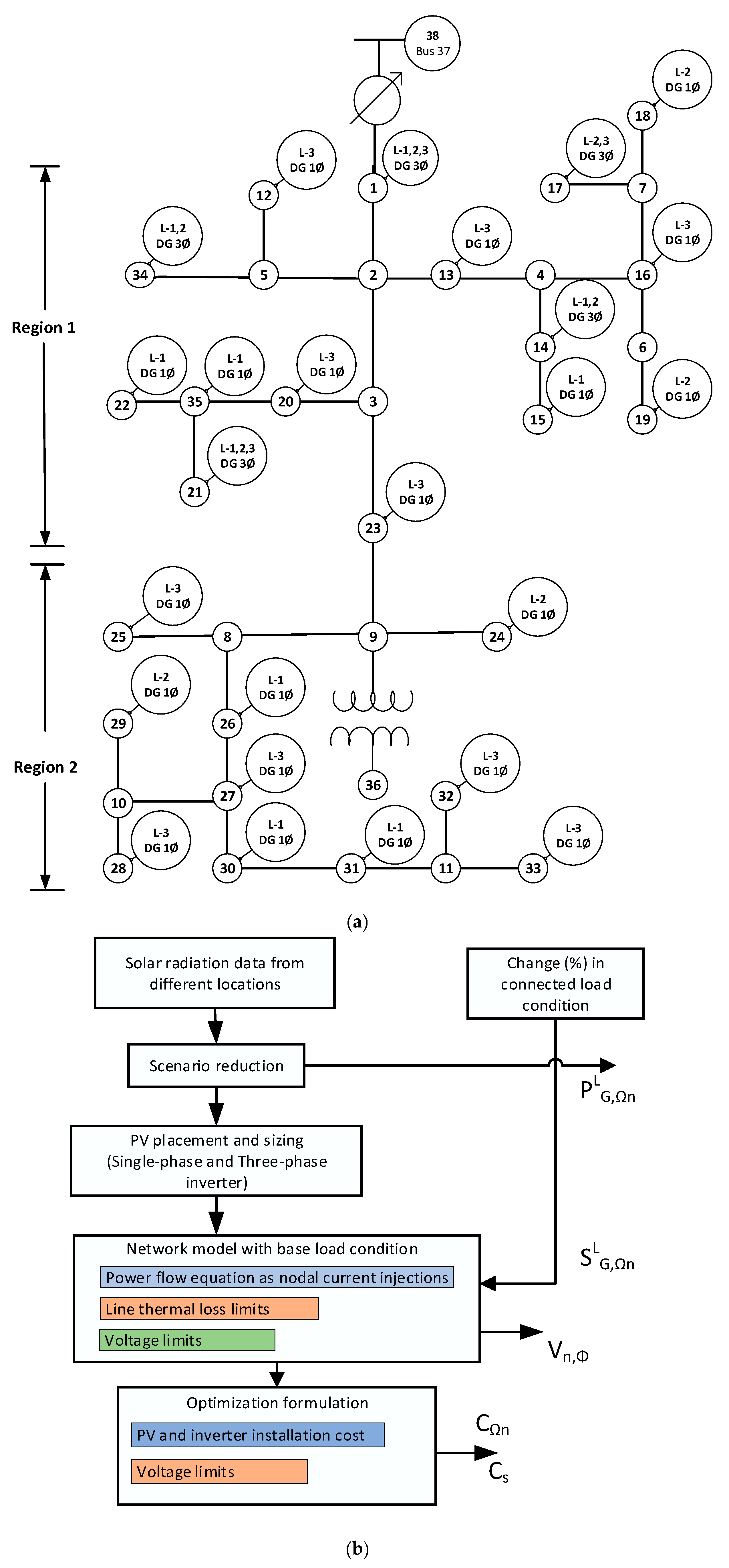
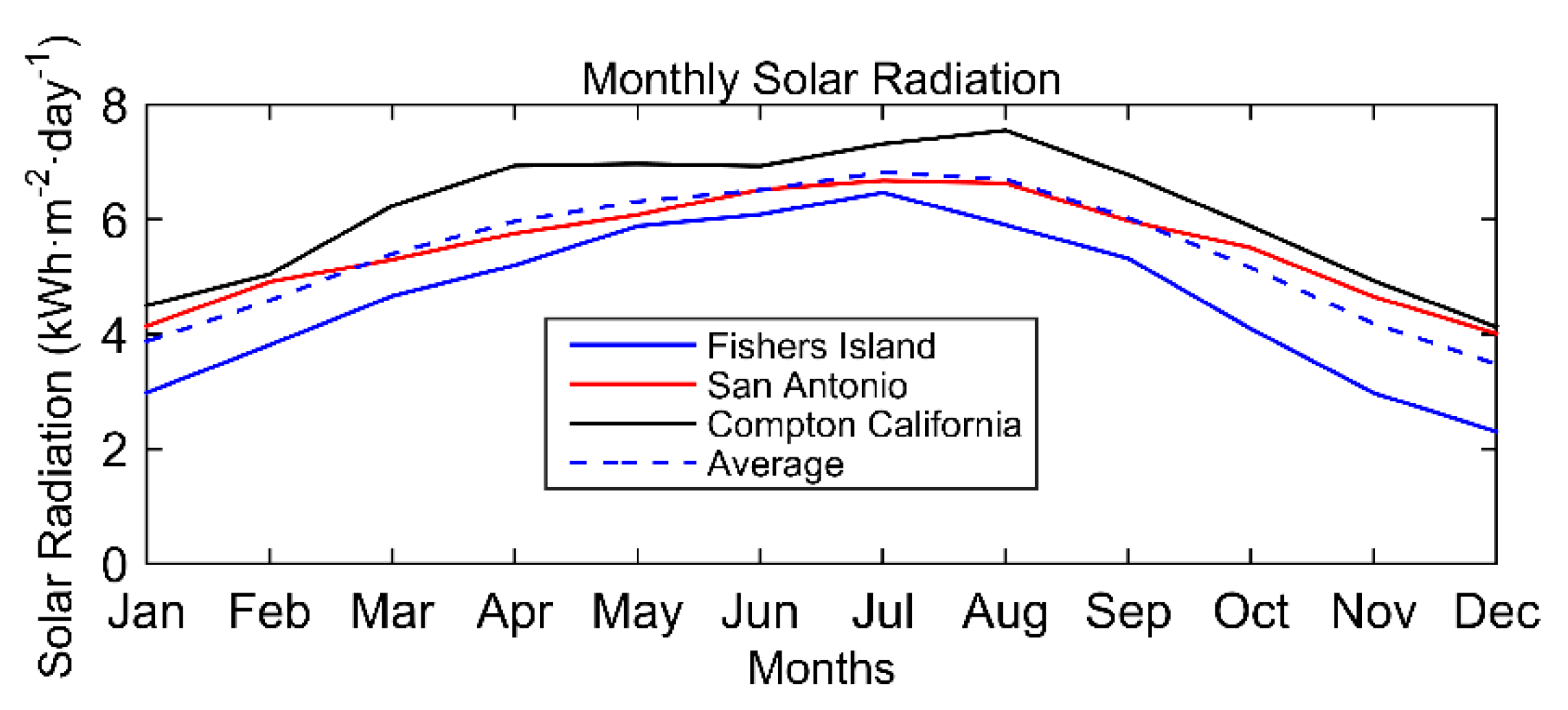

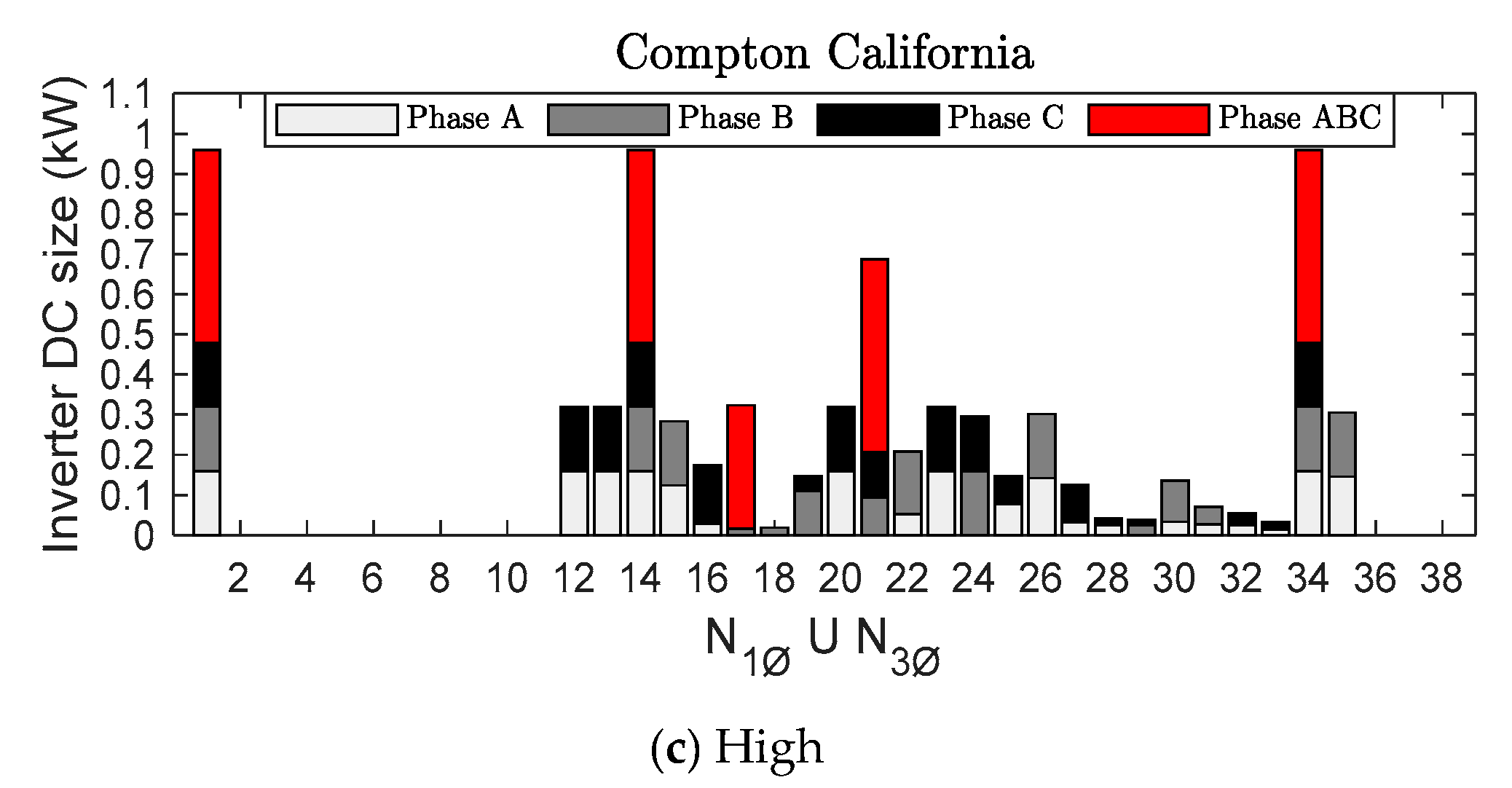
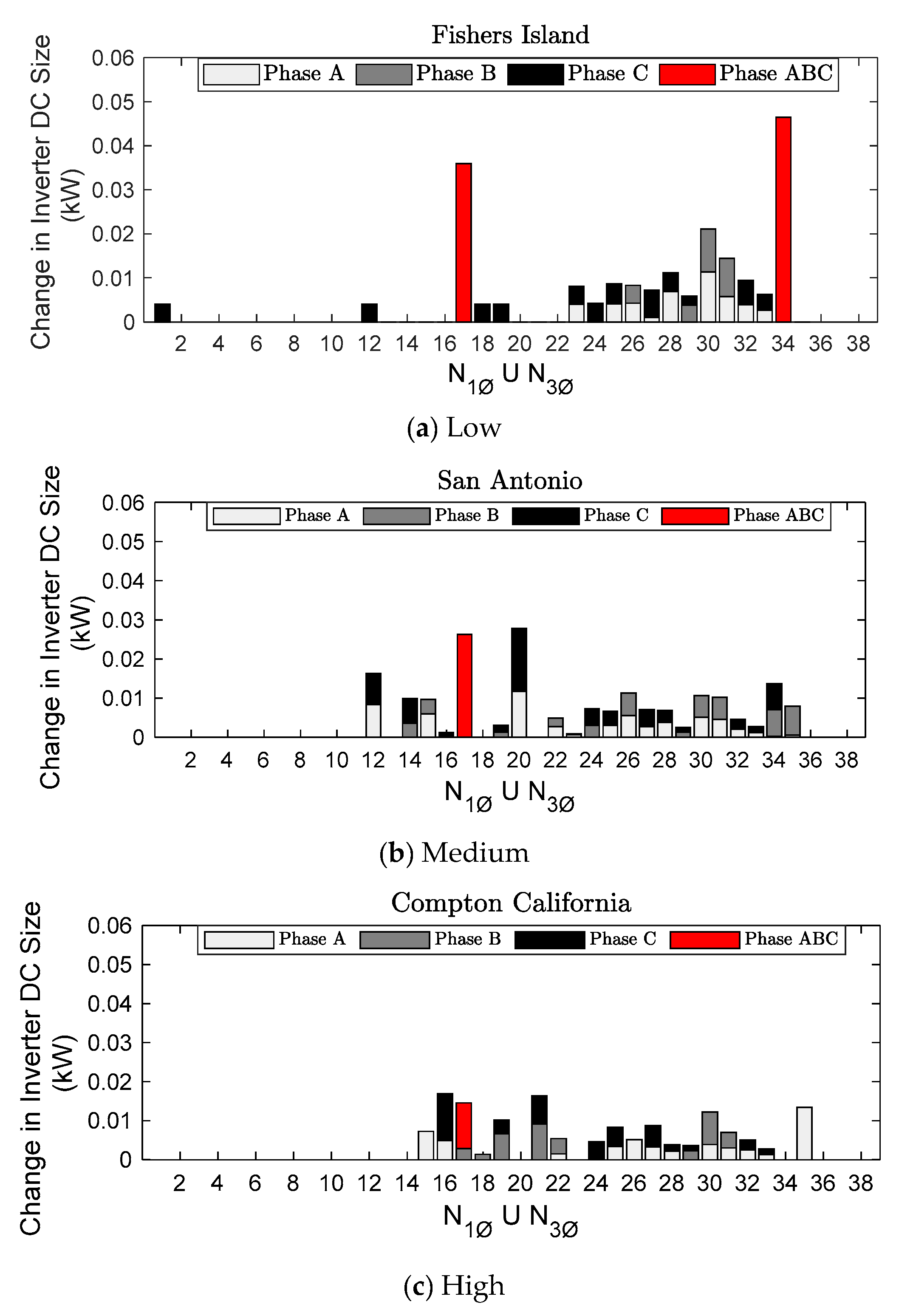

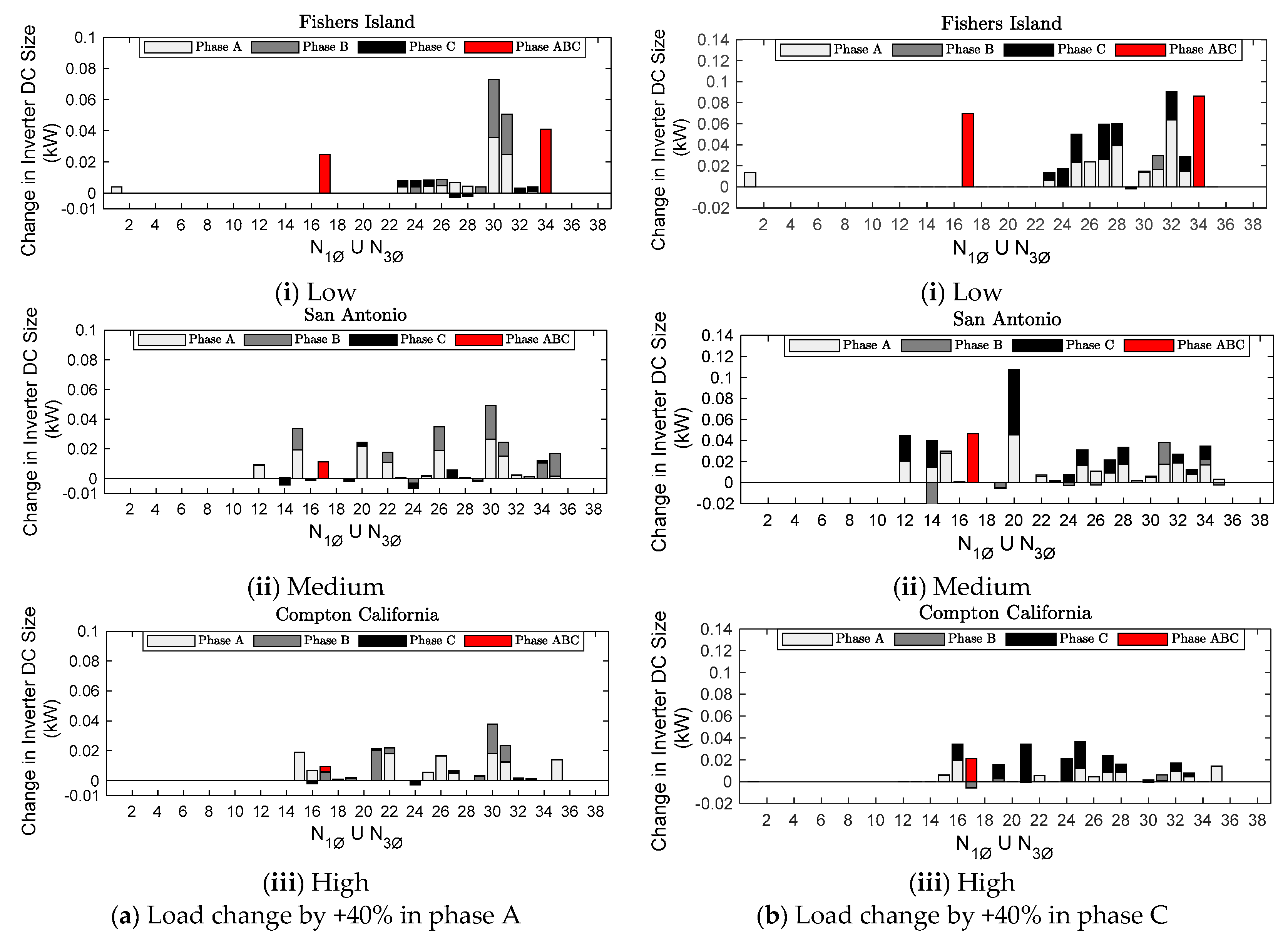
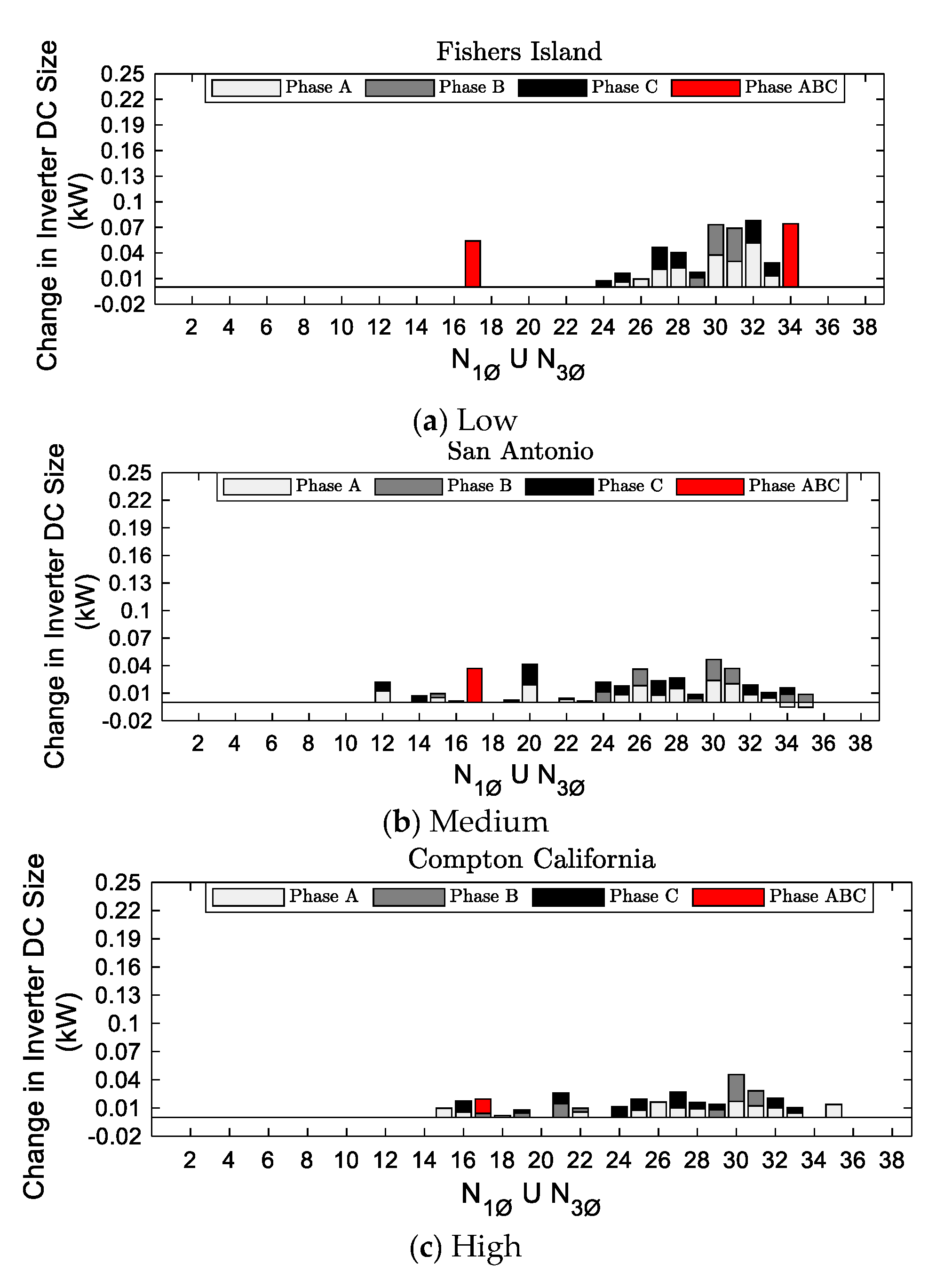

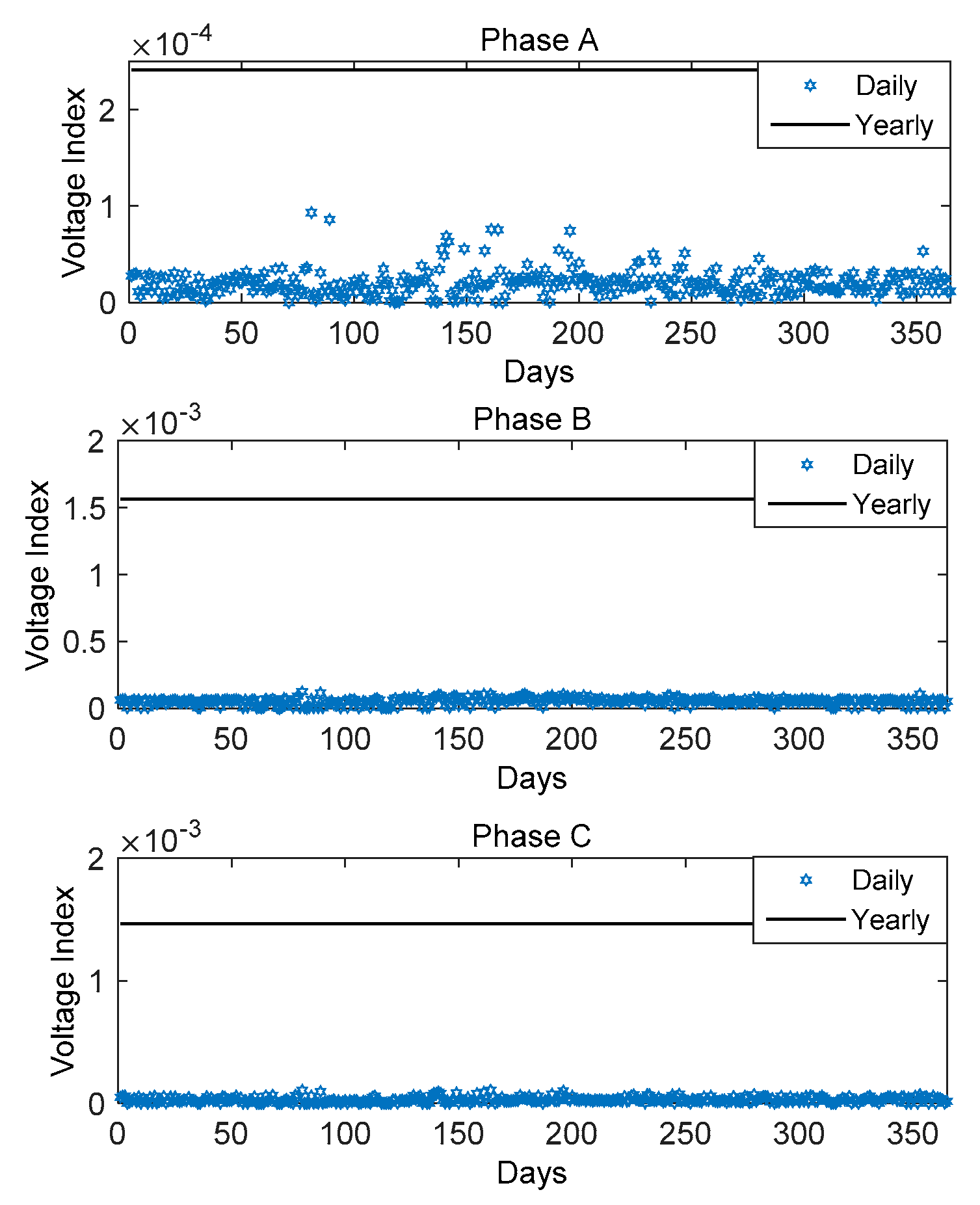


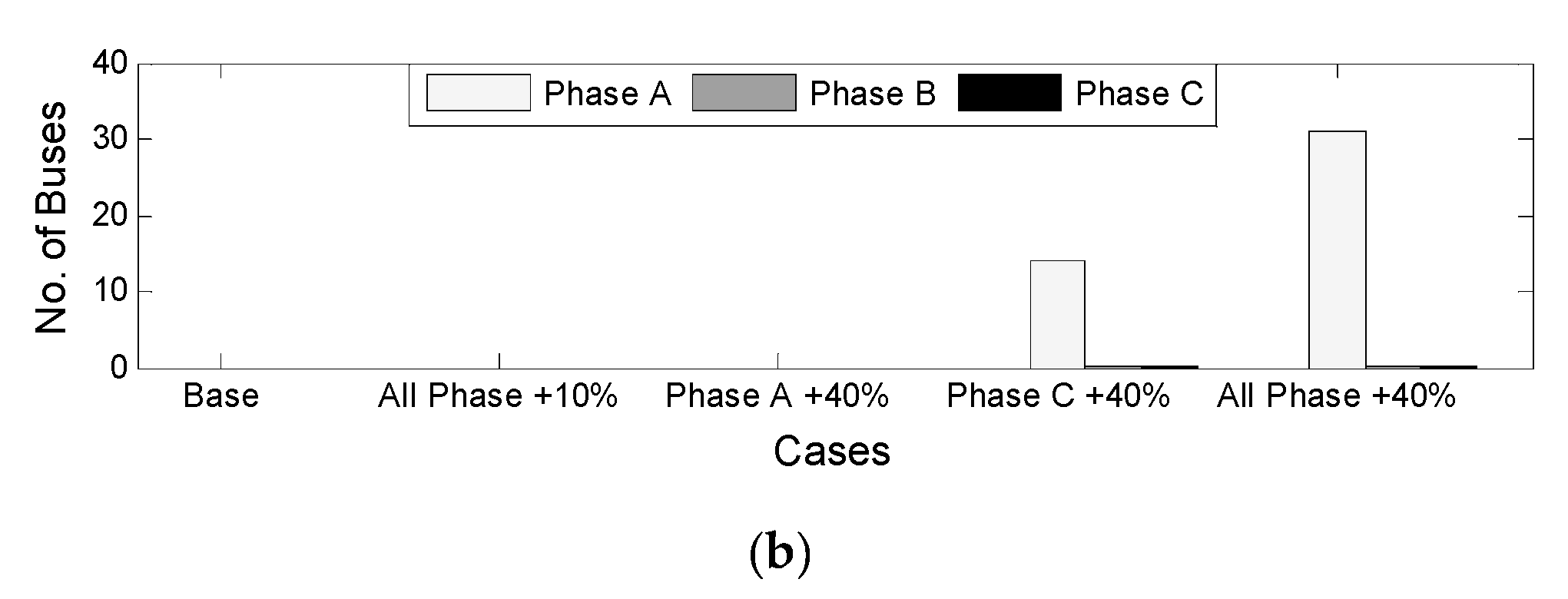
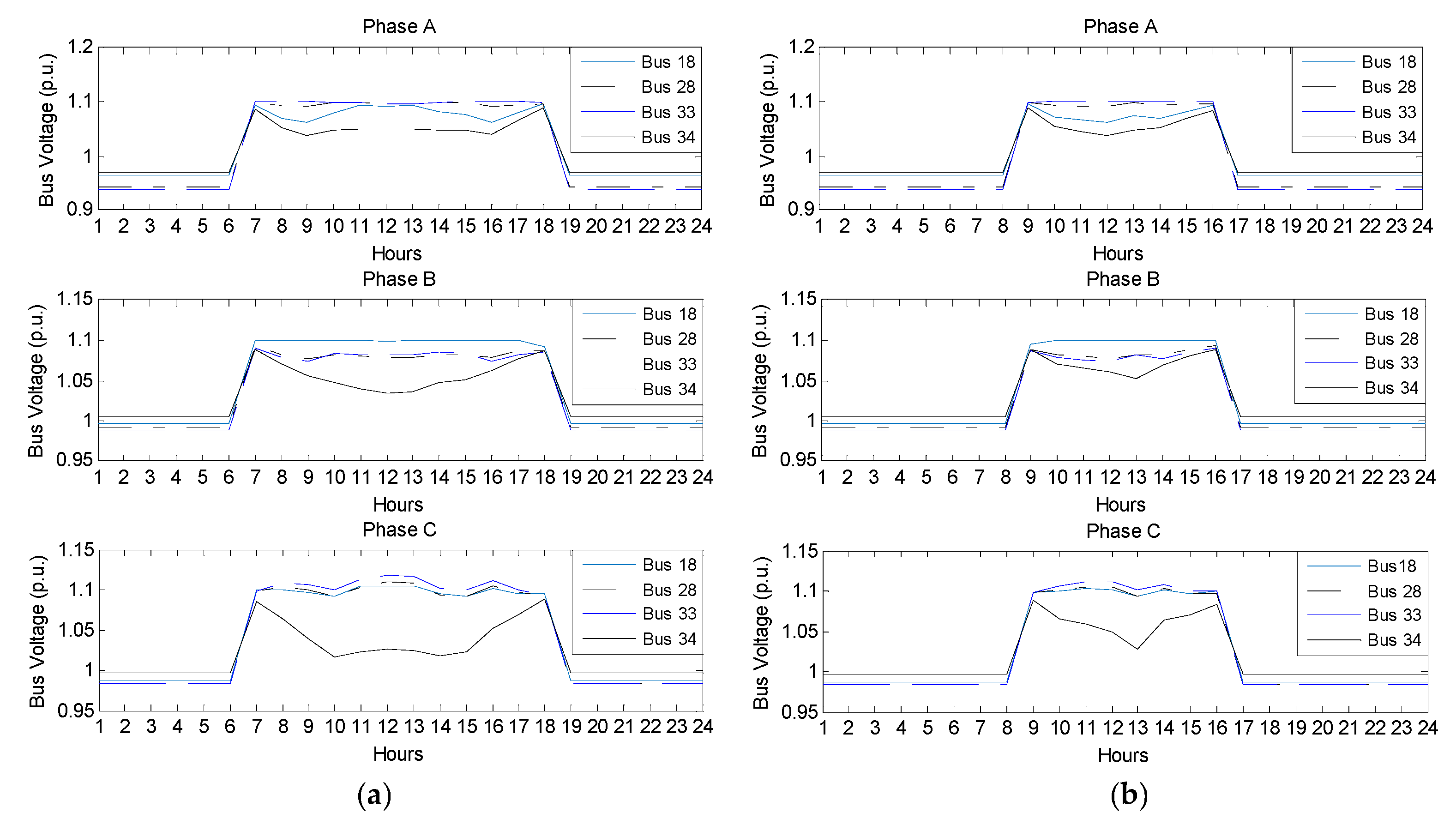
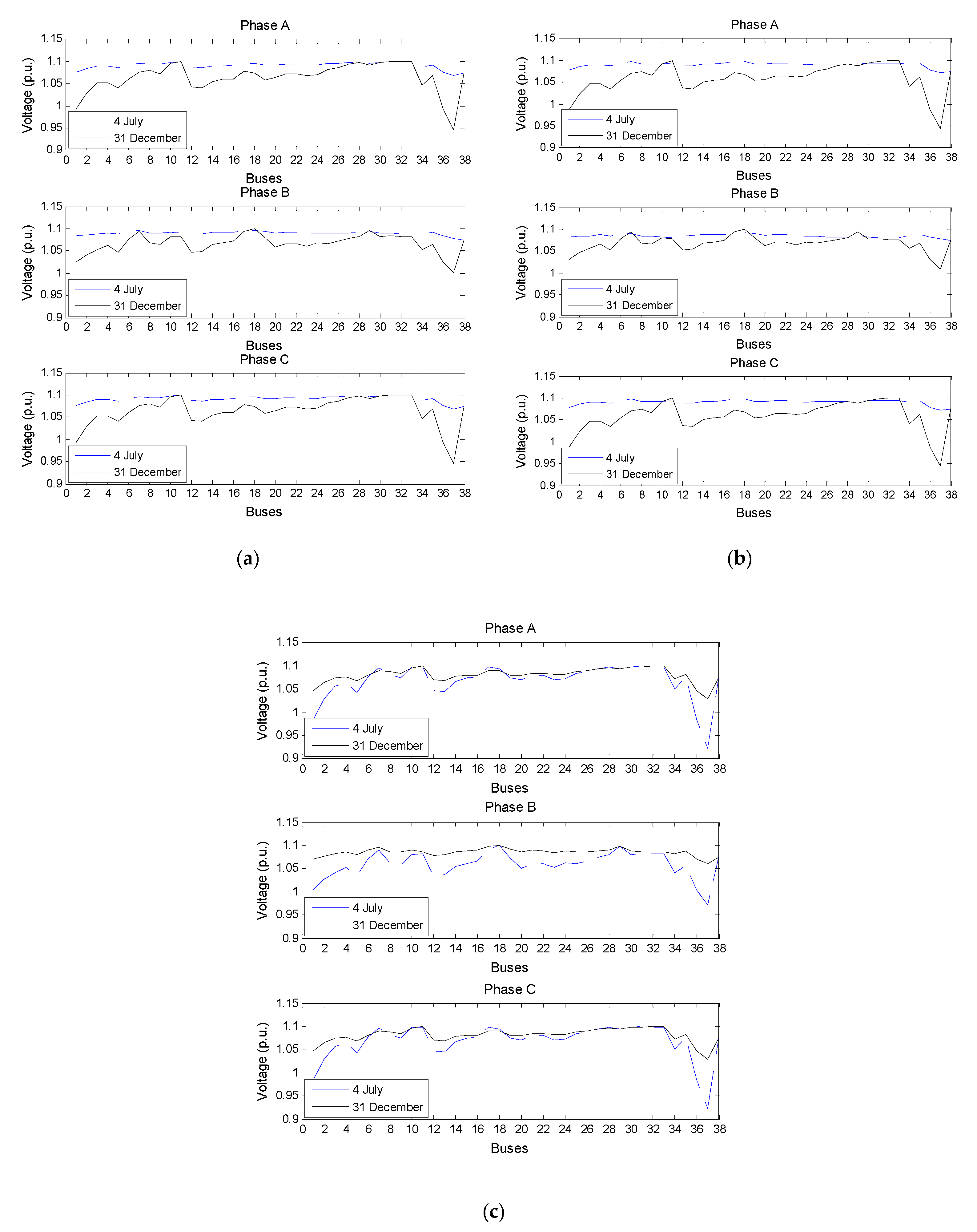
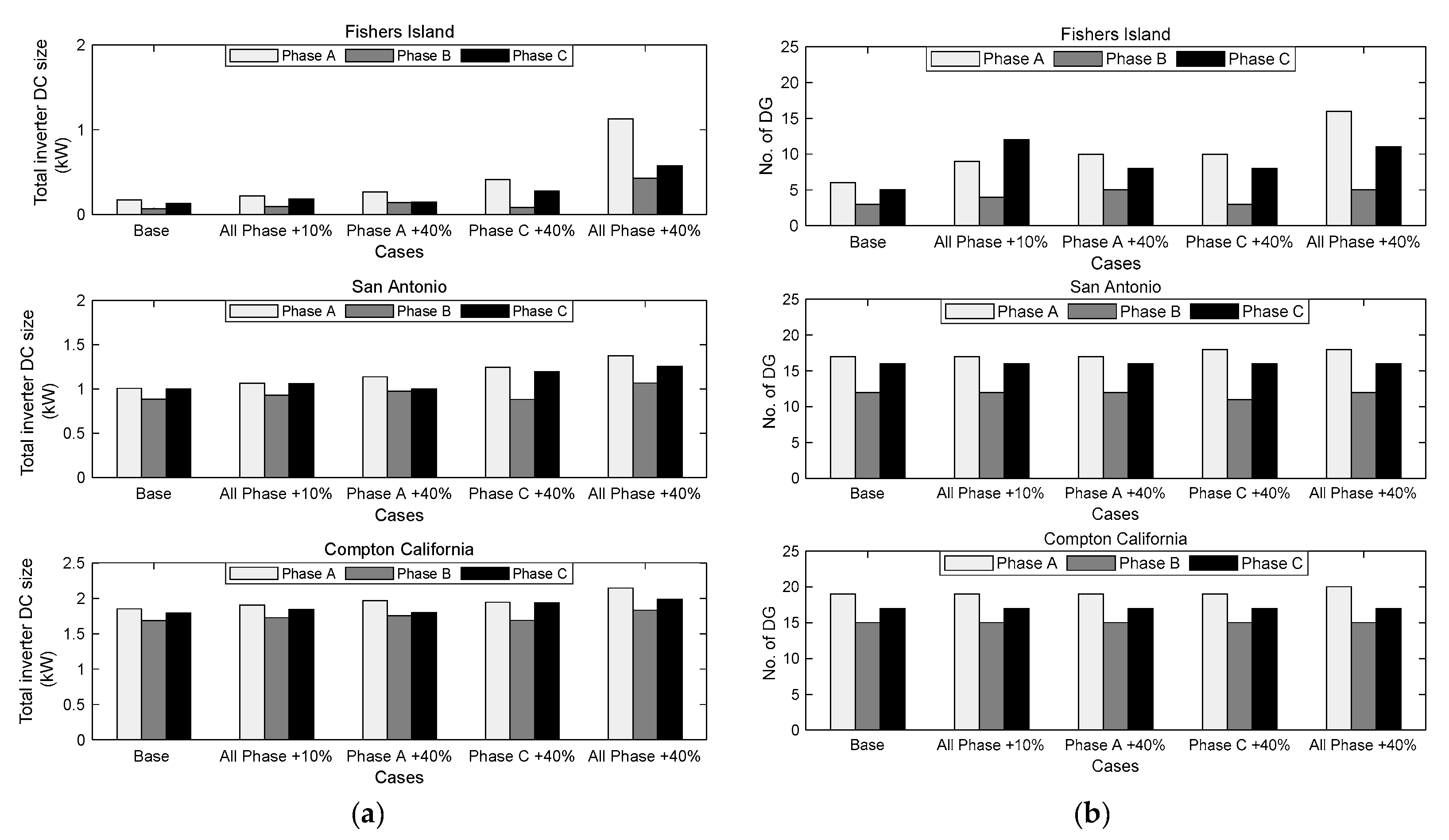

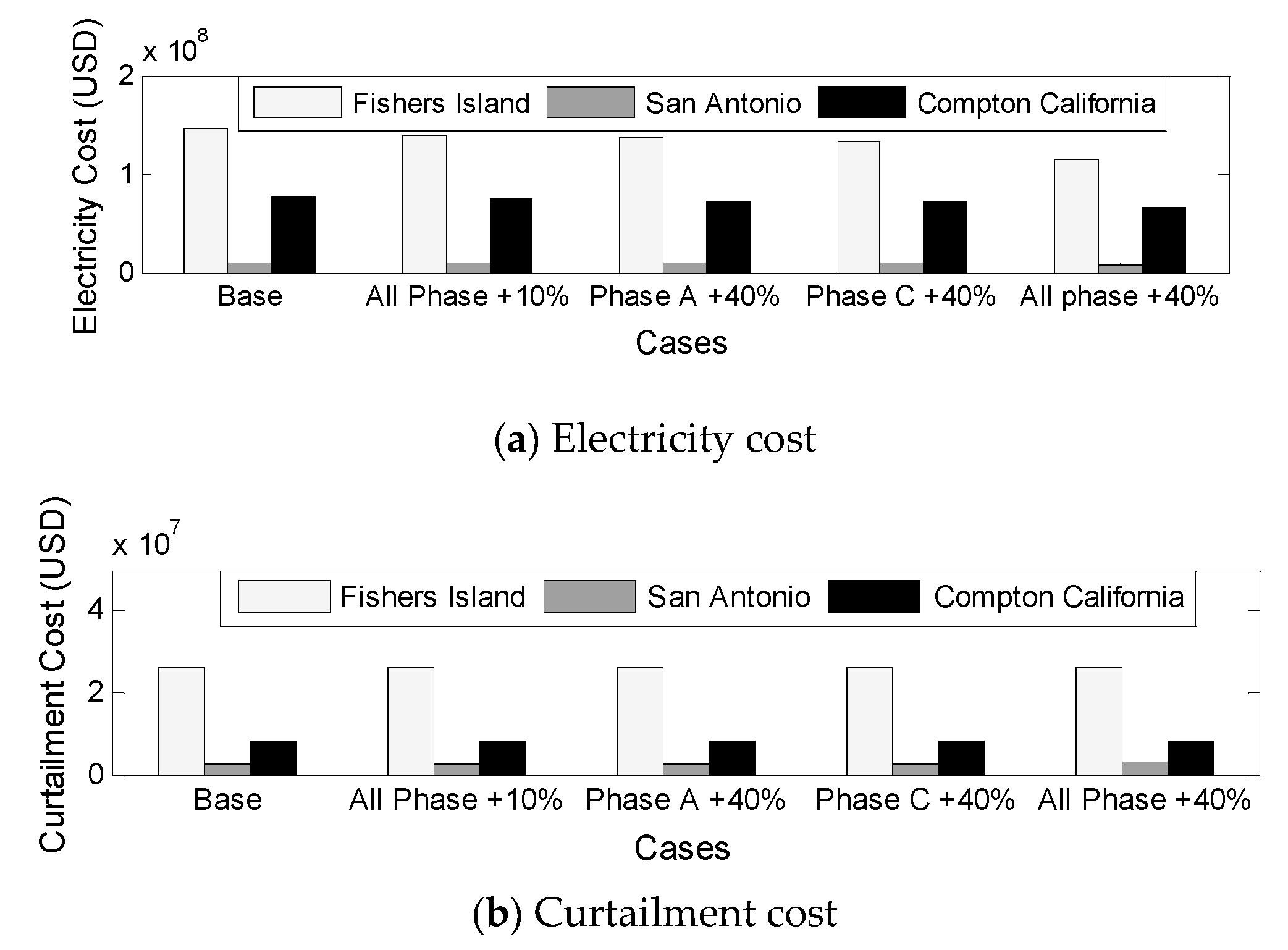
Disclaimer/Publisher’s Note: The statements, opinions and data contained in all publications are solely those of the individual author(s) and contributor(s) and not of MDPI and/or the editor(s). MDPI and/or the editor(s) disclaim responsibility for any injury to people or property resulting from any ideas, methods, instructions or products referred to in the content. |
© 2023 by the authors. Licensee MDPI, Basel, Switzerland. This article is an open access article distributed under the terms and conditions of the Creative Commons Attribution (CC BY) license (https://creativecommons.org/licenses/by/4.0/).
Share and Cite
Yadav, A.; Kishor, N.; Negi, R. Bus Voltage Violations under Different Solar Radiation Profiles and Load Changes with Optimally Placed and Sized PV Systems. Energies 2023, 16, 653. https://doi.org/10.3390/en16020653
Yadav A, Kishor N, Negi R. Bus Voltage Violations under Different Solar Radiation Profiles and Load Changes with Optimally Placed and Sized PV Systems. Energies. 2023; 16(2):653. https://doi.org/10.3390/en16020653
Chicago/Turabian StyleYadav, Anju, Nand Kishor, and Richa Negi. 2023. "Bus Voltage Violations under Different Solar Radiation Profiles and Load Changes with Optimally Placed and Sized PV Systems" Energies 16, no. 2: 653. https://doi.org/10.3390/en16020653
APA StyleYadav, A., Kishor, N., & Negi, R. (2023). Bus Voltage Violations under Different Solar Radiation Profiles and Load Changes with Optimally Placed and Sized PV Systems. Energies, 16(2), 653. https://doi.org/10.3390/en16020653




